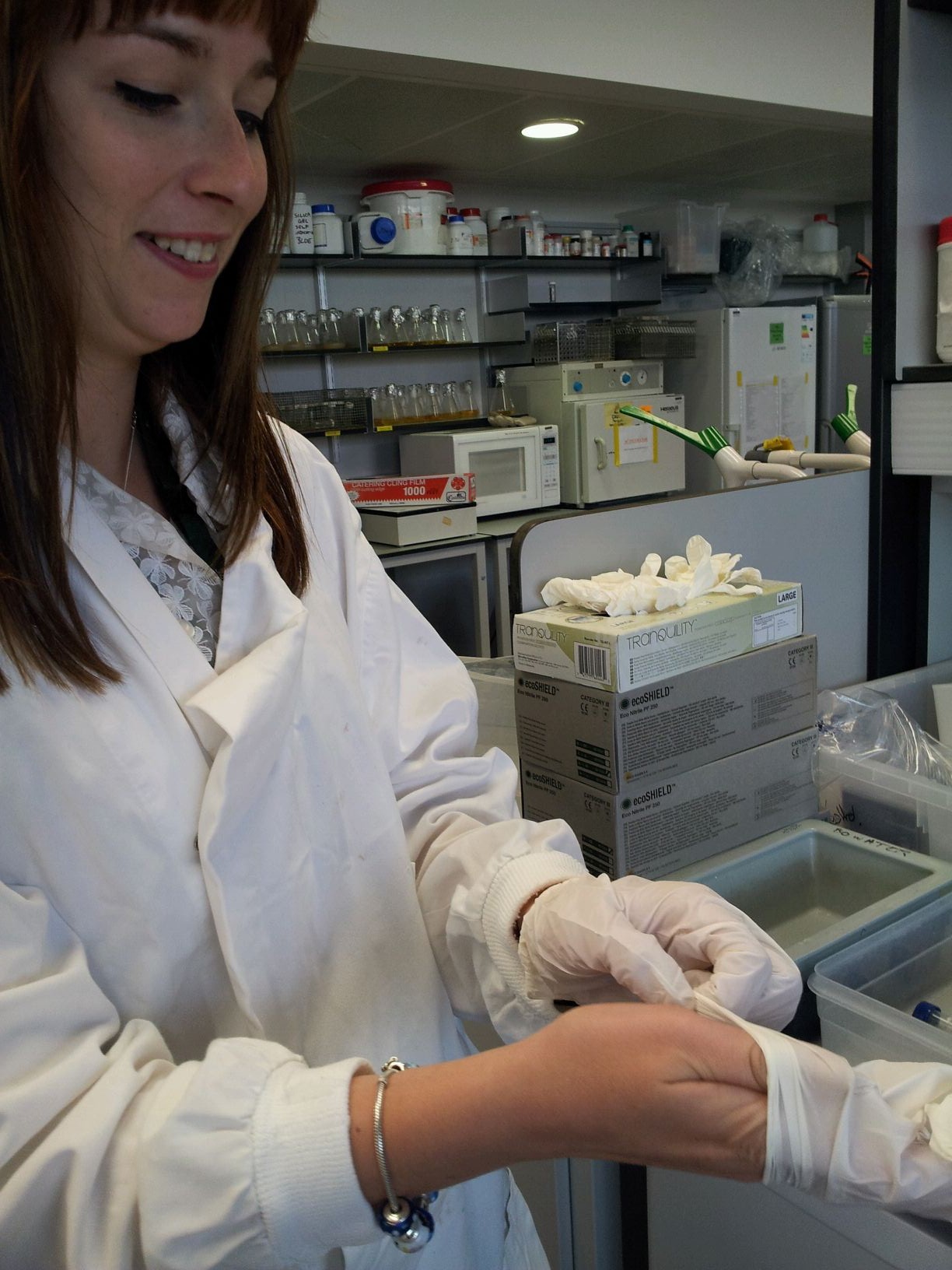Team:NRP-UEA-Norwich/Safety
From 2012.igem.org
(→Researcher safety) |
|||
| (8 intermediate revisions not shown) | |||
| Line 13: | Line 13: | ||
| - | The team had originally thought it would be interesting to look at NO levels within "Salmonella", but decided later that this would result in a lot more safety concerns and complications. Therefore, the team decided to only use strains of ''E.coli'' (which they had all used within their university studies before and were allowed to handle within the lab) within our projects. NEB 5-alpha ''E.coli'' was used to characterize existing | + | The team had originally thought it would be interesting to look at NO levels within "Salmonella", but decided later that this would result in a lot more safety concerns and complications. Therefore, the team decided to only use strains of ''E.coli'' (which they had all used within their university studies before and were allowed to handle within the lab) within our projects. NEB 5-alpha ''E.coli'' was used to characterize existing BioBricks, as well as BL21 pLysS ''E. coli'' cells and Alpha select gold ''E.coli''. ''E.coli'' is a well-studied species of bacteria, with fairly predictable behavior, as well as being non-pathogenic (a bio safety level 1 bacteria). Therefore, all the students were able to use the ''E.coli'' within the university’s second year (category one and two) teaching labs. |
| Line 33: | Line 33: | ||
The team always removed their lab coats and gloves, as well as washed their hands, before leaving the lab. This reduced the chance of bringing harmful bacteria or substances outside the laboratory environment. The team also took care to keep the laboratory windows shut, in order to reduce exposure to the outside world. | The team always removed their lab coats and gloves, as well as washed their hands, before leaving the lab. This reduced the chance of bringing harmful bacteria or substances outside the laboratory environment. The team also took care to keep the laboratory windows shut, in order to reduce exposure to the outside world. | ||
| + | |||
All contaminated waste was autoclaved on site before being collected and disposed of under controlled conditions, or for cleaning for reuse. | All contaminated waste was autoclaved on site before being collected and disposed of under controlled conditions, or for cleaning for reuse. | ||
| + | |||
The team felt that it was important that the public were given the opportunity to understand and ask about procedures used in the laboratory, so they could form informed opinions about the safety and ethical implications of the teams work. The team took the opportunity at their public engagement event to explain the procedures they used in full detail. | The team felt that it was important that the public were given the opportunity to understand and ask about procedures used in the laboratory, so they could form informed opinions about the safety and ethical implications of the teams work. The team took the opportunity at their public engagement event to explain the procedures they used in full detail. | ||
| + | |||
At this public engagement event the team took transformed ''E.coli'' samples to the venues and public safety was a priority. Therefore, the plates were maintained in a UV box behind a sheet of plastic, limiting public physical interaction with the laboratory specimens. These plates were also sealed extensively using parafilm and were kept well away form any part of the venue holding or serving food products. | At this public engagement event the team took transformed ''E.coli'' samples to the venues and public safety was a priority. Therefore, the plates were maintained in a UV box behind a sheet of plastic, limiting public physical interaction with the laboratory specimens. These plates were also sealed extensively using parafilm and were kept well away form any part of the venue holding or serving food products. | ||
| Line 43: | Line 46: | ||
[[File:Rabbits_at_UEA.png| 300px||left ]]Data safety sheets that come with chemicals explain how to dispose of the chemicals correctly. These guidelines were adhered to rigidly since the local water providing company, Anglia water, carry out routine random samples on what is poured down the sink drains, and if a certain volume (volume is unknown to university, which encourages them not to put any waste down the sink) of listed chemicals are found, then the university is fined. | [[File:Rabbits_at_UEA.png| 300px||left ]]Data safety sheets that come with chemicals explain how to dispose of the chemicals correctly. These guidelines were adhered to rigidly since the local water providing company, Anglia water, carry out routine random samples on what is poured down the sink drains, and if a certain volume (volume is unknown to university, which encourages them not to put any waste down the sink) of listed chemicals are found, then the university is fined. | ||
| + | |||
There is a very low risk of damage to the environment as all bacteria will be stored safely within the lab. However, if the bacteria was to unexpectedly be released, there is very little threat on the environment, since the bacteria are standard autotrophic laboratory stains and therefore unlikely to survive. The ''E.coli'' stains used are also unlikely to replicate and therefore spread. Finally, due to using plasmids with a narrow host range horizontal gene transfer between bacteria within the environment is also very unlikely, as plasmids would not replicate if transferred to other organisms. | There is a very low risk of damage to the environment as all bacteria will be stored safely within the lab. However, if the bacteria was to unexpectedly be released, there is very little threat on the environment, since the bacteria are standard autotrophic laboratory stains and therefore unlikely to survive. The ''E.coli'' stains used are also unlikely to replicate and therefore spread. Finally, due to using plasmids with a narrow host range horizontal gene transfer between bacteria within the environment is also very unlikely, as plasmids would not replicate if transferred to other organisms. | ||
| - | |||
| - | |||
=Safety issues our BioBrick parts could raise:= | =Safety issues our BioBrick parts could raise:= | ||
The first BioBricks made by the NRP-UEA iGEM team are hybrid promoters consisting of a bacterial promoter (B) fused to a mammalian promoter (M); this has been carried out in two orientations, B upstream from M (B-M), and M upstream from B (M-B). As this is a new concept the BioBricks safety concerns arise, due to the lack of knowledge surrounding how the promoters will interact with one another. The team has not submitted any issues to the registry thus far as no specific issues have arisen, there are no specific concerns regarding the DNA sequence and both promoters are individually well characterised; however the team remains vigilant and understands that with unknown BioBricks such as B-M and M-B there is always the chance for something unexpected to occur. | The first BioBricks made by the NRP-UEA iGEM team are hybrid promoters consisting of a bacterial promoter (B) fused to a mammalian promoter (M); this has been carried out in two orientations, B upstream from M (B-M), and M upstream from B (M-B). As this is a new concept the BioBricks safety concerns arise, due to the lack of knowledge surrounding how the promoters will interact with one another. The team has not submitted any issues to the registry thus far as no specific issues have arisen, there are no specific concerns regarding the DNA sequence and both promoters are individually well characterised; however the team remains vigilant and understands that with unknown BioBricks such as B-M and M-B there is always the chance for something unexpected to occur. | ||
| + | |||
| + | |||
[[File:MB.png|200px|right]] | [[File:MB.png|200px|right]] | ||
[[File:BM.png|200px|right]] | [[File:BM.png|200px|right]] | ||
The team has also synthesised a second new construct known as the comparator circuit, which again is not well characterised. Through its intended use is as a gene regulation component a risk arises in that the comparator circuit could possibly join to unintended, functional genes and affect their regulation. As no specific issues have arisen yet no issues have been added to the registry, however upon characterisation of the BioBricks any issues that do arise will immediately be included with the part. | The team has also synthesised a second new construct known as the comparator circuit, which again is not well characterised. Through its intended use is as a gene regulation component a risk arises in that the comparator circuit could possibly join to unintended, functional genes and affect their regulation. As no specific issues have arisen yet no issues have been added to the registry, however upon characterisation of the BioBricks any issues that do arise will immediately be included with the part. | ||
| + | |||
Throughout the project the team handled all safety issues by following and complying with both government safety standards as well as university safety standards. The team has also inserted the BioBricks into narrow host-range plasmids (as produced by iGEM), thus reducing the chances of horizontal gene transfer. BioBricks of B-M, M-B, and the comparator circuit, were all transformed into standard BSL1 laboratory autotrophic strains of ''E. coli'' and are therefore unlikely to survive outside of the laboratory. | Throughout the project the team handled all safety issues by following and complying with both government safety standards as well as university safety standards. The team has also inserted the BioBricks into narrow host-range plasmids (as produced by iGEM), thus reducing the chances of horizontal gene transfer. BioBricks of B-M, M-B, and the comparator circuit, were all transformed into standard BSL1 laboratory autotrophic strains of ''E. coli'' and are therefore unlikely to survive outside of the laboratory. | ||
| + | |||
Future iGEM teams could increase their safety by connecting the B-M and M-B BioBricks to a suicide gene. This would mean that in the unlikely event of the transformed cells being released into the environment and unintended bacteria taking up the BioBrick-containing plasmid, the unintended bacteria would be destroyed and further spread of the hybrid promoter BioBricks would be prevented. | Future iGEM teams could increase their safety by connecting the B-M and M-B BioBricks to a suicide gene. This would mean that in the unlikely event of the transformed cells being released into the environment and unintended bacteria taking up the BioBrick-containing plasmid, the unintended bacteria would be destroyed and further spread of the hybrid promoter BioBricks would be prevented. | ||
| Line 62: | Line 68: | ||
=The University of East Anglia's biosafety review board= | =The University of East Anglia's biosafety review board= | ||
| - | UEA takes both staff and student safety very seriously and has its own health and safety policies and biosaftey rules that must be followed:[ | + | UEA takes both staff and student safety very seriously and has its own health and safety policies and biosaftey rules that must be followed: [https://static.igem.org/mediawiki/2012/2/2e/UEA_GMO_rules.pdf UEA Genetically Modified Organisms Guidelines], [https://static.igem.org/mediawiki/2012/6/65/UEA_statment_of_health_and_saftey_policy.pdf UEA Health and Saftey Policy] and [https://static.igem.org/mediawiki/2012/6/68/UEA_Microbiological_saftey_rules.pdf UEA Microbiological Saftey Rules and Guidelines]. These have been created to follow the guidelines and biosafty rules that have to be considered in the United Kingdom as seen here [http://www.hse.gov.uk/biosafety/gmo/law.htm 'GMOs and the Law'] and [http://www.hse.gov.uk/biosafety/gmo/acgm/acgmcomp 'The SACGM Compendium of guidance']. All of our projects are in compliance with both university requirements and national regulations. |
| + | |||
The university also has its own biosafety committee in which the responsibilities of different aspects of safety are split between departments and staff. Dr Andrew Hemmings is the BIO safety officer at UEA and spoke to members of the team about the project and discussed whether our COSH forms covered the processes carried out. The team then discussed their project further with other members of staff including Dr Mark Coleman, university GMO safety officer, and Dr Gabriella Kelemen, university microbial safety officer. | The university also has its own biosafety committee in which the responsibilities of different aspects of safety are split between departments and staff. Dr Andrew Hemmings is the BIO safety officer at UEA and spoke to members of the team about the project and discussed whether our COSH forms covered the processes carried out. The team then discussed their project further with other members of staff including Dr Mark Coleman, university GMO safety officer, and Dr Gabriella Kelemen, university microbial safety officer. | ||
| + | |||
When speaking to members of the UEA biosafty team there was no concern with the processes being carried out and the bacteria being used. When the team spoke to GMO safety officer, Dr Mark Coleman, about the safety of the BioBricks they intended to create he said "there is a highly improbable chance this project poses a significant risk to either human health or the environment". | When speaking to members of the UEA biosafty team there was no concern with the processes being carried out and the bacteria being used. When the team spoke to GMO safety officer, Dr Mark Coleman, about the safety of the BioBricks they intended to create he said "there is a highly improbable chance this project poses a significant risk to either human health or the environment". | ||
| Line 72: | Line 80: | ||
Although the team started looking at NO, the dangers of unintentional exposure to NO soon became clear. Therefore, the team would hope that through using systems similar to our comparator sensor, NO sensors will be produced that are in the form of a sheet of paper and can be placed on the wall of labs, and buildings ect, to indicate excess levels of NO visually. | Although the team started looking at NO, the dangers of unintentional exposure to NO soon became clear. Therefore, the team would hope that through using systems similar to our comparator sensor, NO sensors will be produced that are in the form of a sheet of paper and can be placed on the wall of labs, and buildings ect, to indicate excess levels of NO visually. | ||
| - | The team | + | |
| + | The team feels that future iGEM teams could aim to reduce the chance of horizontal gene transfer further by reducing the adherence between the transformed cells and others, or via the prevention of transformations without inducing competency. This would be a procedure to prevent some cases of antibiotic genes being passed through between bacterial species. However, a variety of other safeguards could also be deployed to prevent this. | ||
Latest revision as of 02:02, 27 September 2012
 "
"





